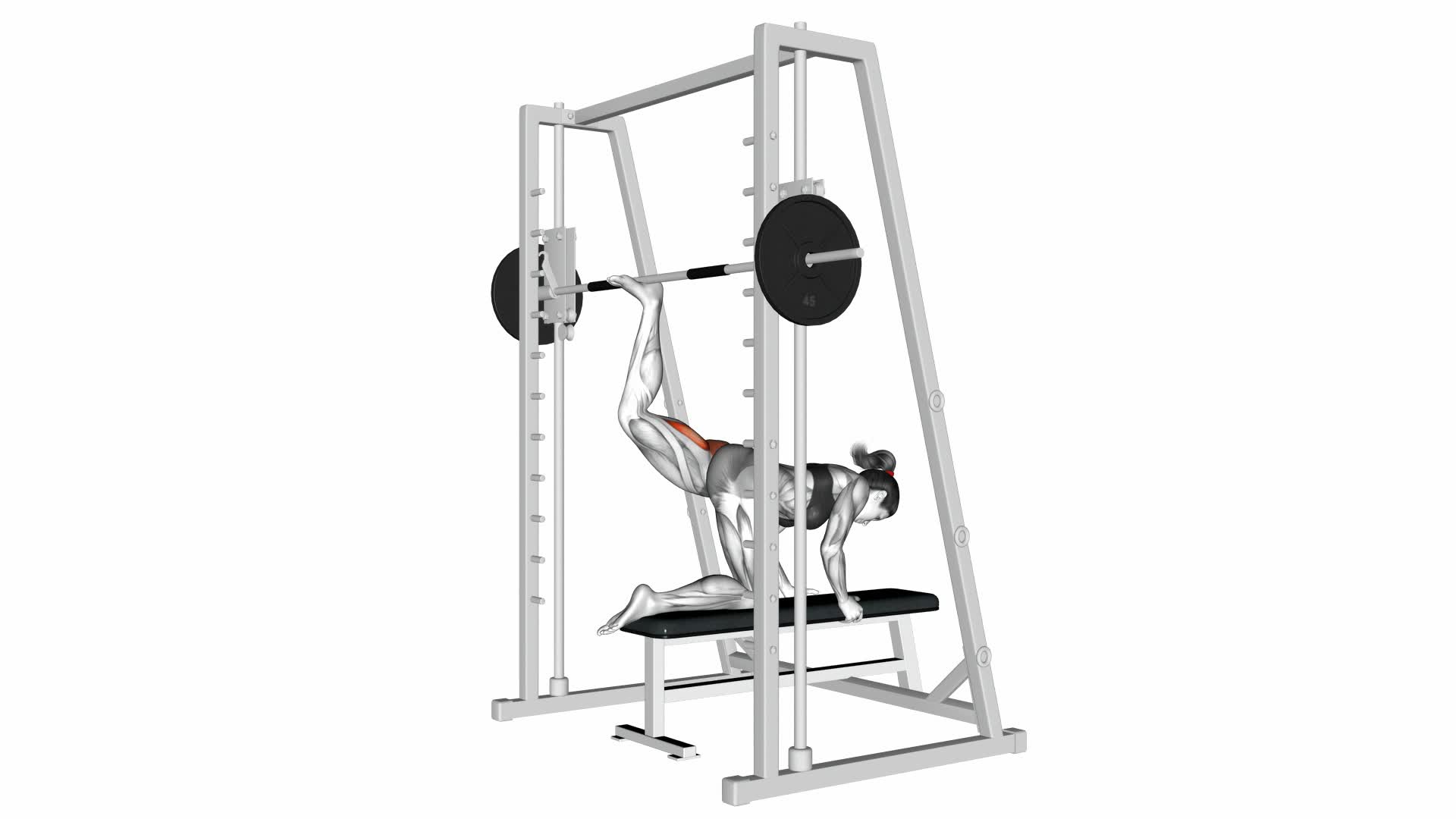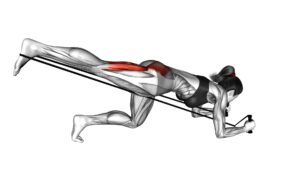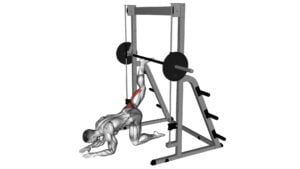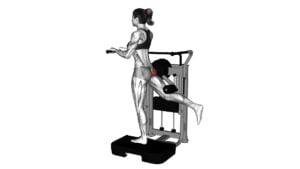Smith Kneeling Rear Kick – Video Exercise Guide & Tips

Are you looking to strengthen your lower body and improve your kicking power? Look no further than the Smith Kneeling Rear Kick!
Watch This Exercise Video
In this article, we'll guide you through this effective exercise with a video demonstration and provide you with valuable tips to perfect your technique. Whether you're a beginner or advanced fitness enthusiast, incorporating the Smith Kneeling Rear Kick into your workout routine will take your leg strength to new heights.
Let's get started!
Key Takeaways
- The Smith Kneeling Rear Kick targets glutes, hamstrings, and lower back muscles.
- It improves hip mobility and stability, enhances posture and core strength.
- The exercise engages multiple muscle groups simultaneously and increases heart rate for a full-body workout.
- The Smith Kneeling Rear Kick can be modified for different fitness levels and is beneficial for strengthening and toning the lower body.
Benefits of the Smith Kneeling Rear Kick
To maximize your workout, the Smith Kneeling Rear Kick offers a range of benefits that enhance your strength and flexibility. This exercise targets your glutes, hamstrings, and lower back muscles. By performing different variations of the Smith kneeling rear kick, you can adjust the intensity and focus on specific muscle groups.
One variation is the single-leg Smith kneeling rear kick, which isolates each leg and increases stability and balance. Another variation is the Smith kneeling rear kick with resistance bands, which adds extra resistance and challenges your muscles even more. This variation can help you build strength and power.
The Smith kneeling rear kick benefits go beyond just muscle development. This exercise also improves your hip mobility and stability, which is essential for athletic activities and everyday movements. Additionally, it helps to improve your posture and core strength, as it engages your abs and lower back muscles.
To perform the Smith kneeling rear kick, start by kneeling on a mat or bench with your hands on the floor for support. Extend one leg back and kick it up towards the ceiling, keeping your core engaged and back straight. Repeat on the other side.
Incorporating the Smith kneeling rear kick variations into your workout routine will help you achieve a stronger lower body, improved flexibility, and enhanced overall fitness.
Proper Technique for the Smith Kneeling Rear Kick
When performing the Smith Kneeling Rear Kick, it's important to maintain proper technique and form. This won't only ensure maximum effectiveness of the exercise but also minimize the risk of injury.
Here are three key points to remember for proper execution:
- Maintain knee stability: Throughout the movement, it's crucial to keep your knee stable and in line with your toes. Avoid any inward or outward rotation of the knee to prevent strain or potential injury. Engage your core muscles to help stabilize your knee joint.
- Activate your glutes: To fully benefit from the Smith Kneeling Rear Kick, it's essential to activate your glute muscles. As you extend your leg backward, focus on squeezing your glutes to initiate the movement. This will help strengthen your glutes and improve overall hip stability.
- Control your movements: Avoid using momentum or swinging your leg during the exercise. Instead, concentrate on controlled movements, emphasizing the contraction of your glutes as you kick back. Slow and controlled movements will provide better muscle activation and prevent any unnecessary strain on your joints.
Common Mistakes to Avoid When Performing the Smith Kneeling Rear Kick
You should avoid making these common mistakes when performing the Smith Kneeling Rear Kick.
One common mistake isn't maintaining proper form throughout the exercise. It's important to keep your back straight and core engaged to avoid straining your lower back.
Another mistake is using too much momentum to execute the kick. Remember, this exercise is about control and stability, so try to focus on using your glutes and hamstrings to power the movement, rather than relying on swinging your leg.
Additionally, be mindful of your foot placement. Placing your foot too close to your body can limit the range of motion and reduce the effectiveness of the exercise. Instead, aim to position your foot at a comfortable distance that allows for a full extension of your leg during the kick.
By avoiding these common mistakes and practicing the proper technique, you can maximize the benefits of the Smith Kneeling Rear Kick and prevent potential injuries.
Now, let's move on to the next section, where we'll explore variations and modifications for the Smith Kneeling Rear Kick.
Variations and Modifications for the Smith Kneeling Rear Kick
Now let's explore different ways to modify and vary the Smith Kneeling Rear Kick exercise, allowing you to target different muscle groups and challenge yourself further. Here are some variations and modifications you can try:
- Single-Leg Smith Kneeling Rear Kick: Perform the exercise on one leg at a time, focusing on stability and balance. This variation increases the difficulty and targets your glutes and hamstrings even more.
- Smith Kneeling Rear Kick with Resistance Bands: Attach a resistance band to the Smith machine and loop it around your foot. As you kick back, the band will provide additional resistance, intensifying the workout and engaging your glutes and hamstrings even further.
- Smith Kneeling Rear Kick with Dumbbells: Hold a pair of dumbbells in your hands while performing the exercise. This modification adds weight to the movement, increasing the challenge and targeting your glutes and hamstrings.
By incorporating these variations and modifications, you can add variety to your workout routine and target different muscle groups.
Now, let's move on to the next section to learn some tips for incorporating the Smith Kneeling Rear Kick into your workout routine.
Tips for Incorporating the Smith Kneeling Rear Kick Into Your Workout Routine
Looking to maximize your workout routine? Need tips on how to effectively incorporate the Smith Kneeling Rear Kick? Here are some suggestions to help you make the most of this exercise and add it to your routine.
Firstly, if you're a beginner or new to this exercise, it's important to start with modifications. Instead of using weights, you can begin by practicing the movement without any added resistance. This will allow you to focus on your form and ensure that you're performing the exercise correctly. Once you feel comfortable, you can gradually add weights to increase the challenge.
To further enhance the benefits of the Smith Kneeling Rear Kick, try combining it with other lower body exercises. For example, you can perform a set of Smith Kneeling Rear Kicks followed by squats or lunges. This won't only target your glutes and hamstrings but also engage your quads and calves.
Another option is to incorporate the Smith Kneeling Rear Kick into a circuit training routine. You can alternate between this exercise and other exercises that target different muscle groups. This will help keep your heart rate up and provide a full-body workout.
Remember to always warm up before starting any exercise routine and listen to your body. If you experience any pain or discomfort, stop immediately and consult with a fitness professional. With proper technique and consistency, the Smith Kneeling Rear Kick can be a valuable addition to your workout routine, helping you strengthen and tone your lower body.
Frequently Asked Questions
How Many Calories Does the Smith Kneeling Rear Kick Burn?
The Smith kneeling rear kick is a great exercise for burning calories and incorporating into your workout routine. It targets your glutes, hamstrings, and even your core.
By adding this move to your routine, you can increase the intensity of your workout and burn more calories. To maximize calorie burn, focus on maintaining proper form and engaging your muscles throughout the exercise.
Remember to push through your heel and squeeze your glutes at the top of the movement.
Can the Smith Kneeling Rear Kick Help Improve Flexibility?
The Smith Kneeling Rear Kick can definitely help improve your flexibility. By incorporating this exercise into your routine, you can reap the benefits of dynamic stretching, which include increasing your range of motion and improving mobility.
This exercise targets the muscles in your glutes, hamstrings, and lower back, helping to loosen them up and enhance flexibility. So, if you're looking to improve your flexibility, give the Smith Kneeling Rear Kick a try!
Is the Smith Kneeling Rear Kick Suitable for Beginners?
The Smith kneeling rear kick can be a suitable exercise for beginners. It helps to improve flexibility and strengthen the lower body.
When starting, focus on mastering the basic technique before progressing to more advanced variations. It's important to maintain proper form throughout the exercise to avoid common mistakes such as leaning too far forward or using momentum to generate power.
Take it slow and listen to your body to ensure a safe and effective workout.
Are There Any Alternative Exercises That Target the Same Muscle Groups as the Smith Kneeling Rear Kick?
If you're looking for alternative exercises that target the same muscle groups as the Smith kneeling rear kick, there are a few options you can try.
Lunges and squats are great exercises that engage similar muscles in your legs and glutes.
Another exercise to consider is the standing glute kickback, which specifically targets your glutes.
Remember to focus on proper form and start with lighter weights before progressing to heavier ones.
How Often Should the Smith Kneeling Rear Kick Be Performed for Optimal Results?
For optimal results, it's important to perform the Smith Kneeling Rear Kick with proper form and consistency. This exercise can help improve flexibility and target specific muscle groups.
To maximize its benefits, aim to incorporate this exercise into your workout routine at least 2-3 times a week. Remember to maintain proper form throughout the movement to avoid injuries and ensure effective muscle activation.
Take your time and focus on mastering the technique for optimal results.
Conclusion
Incorporating the Smith Kneeling Rear Kick into your workout routine can bring numerous benefits, such as strengthening your glutes, hamstrings, and core muscles.
By following the proper technique and avoiding common mistakes, you can maximize the effectiveness of this exercise.
Additionally, there are variations and modifications available to suit different fitness levels and goals.
So, add the Smith Kneeling Rear Kick to your routine and elevate your lower body workout to the next level.

Author
Years ago, the spark of my life’s passion ignited in my mind the moment I stepped into the local gym for the first time. The inaugural bead of perspiration, the initial endeavor, the very first surge of endorphins, and a sense of pride that washed over me post-workout marked the beginning of my deep-seated interest in strength sports, fitness, and sports nutrition. This very curiosity blossomed rapidly into a profound fascination, propelling me to earn a Master’s degree in Physical Education from the Academy of Physical Education in Krakow, followed by a Sports Manager diploma from the Jagiellonian University. My journey of growth led me to gain more specialized qualifications, such as being a certified personal trainer with a focus on sports dietetics, a lifeguard, and an instructor for wellness and corrective gymnastics. Theoretical knowledge paired seamlessly with practical experience, reinforcing my belief that the transformation of individuals under my guidance was also a reflection of my personal growth. This belief holds true even today. Each day, I strive to push the boundaries and explore new realms. These realms gently elevate me to greater heights. The unique combination of passion for my field and the continuous quest for growth fuels my drive to break new ground.



